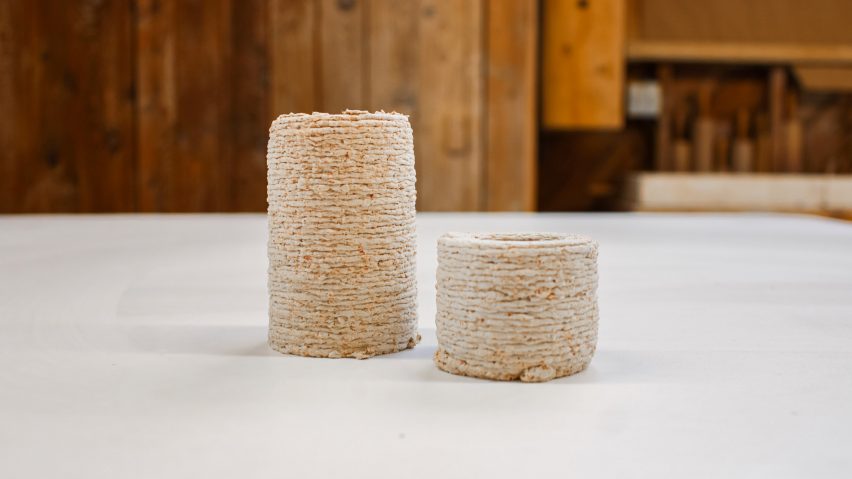Mexican design studio Manufactura and New York studio BioMatters have created 3D-printed objects using a composite consisting mainly of shells from industrial lobstering byproducts in Maine.
During a residency at Haystack Mountain School of Crafts in Maine, the two studios zeroed in on the state's significant lobster production and the waste material from shells, usually developed when lobsters are canned or otherwise processed on-site.
Manufactura and BioMatters crushed the shells of American lobsters into a fine substance and then mixed it with binding agents, such as local clays, before running it through a 3D printer.
"This species, like other arthropods, is protected by an exoskeleton composed of chitin, a carbohydrate also found in fungal cell walls," the team told Dezeen.
"The use of local ceramics, such as porcelain, improves the material's potential strength and makes it suitable for firing, while chitin adds beneficial properties like increased durability, biodegradability, and antibacterial characteristics," it added.
"Although the maximum strength of this composite is still under experimentation and has not yet been verified on-site, this innovative approach highlights the potential for transforming lobster shells, which are typically considered waste, into valuable materials."
The two studios worked with a local manufacturer, Greenhead Lobster, to acquire the shells, most of which normally end up in the trash.
And despite lessening harvests from changing water temperatures and over-fishing, over one hundred million pounds of lobster are caught in Maine each year.
The studios said that the potential for scalability for this material was "promising" but that availability, efficiency and participation from harvesters was necessary to make that happen.
For their experiment, they said that about 15 lobster shells created a full two-kilogram tube for the printer.
The team believes the chitin-based material could be used to replace industrial design products, or items typically made with ceramics only, and ultimately be used in construction.
"Our ultimate motivation is to develop blocks and finishes for building construction, leveraging the unique properties of the lobster shell composite to create sustainable and innovative building materials," it said.
Manufactura consists of Mexican designer Dinorah Schulte, who was recently featured in Dezeen's round-up of independent designers in Mexico City. BioMatters consists of Nancy Diniz and Frank Melendez.
Other recent utilisations of seafood waste for design include a leather-like material by Vietnamese designer Uyen Tran made with discarded shrimp shells and coffee grounds.
The photography is by Dinorah Schulte.

